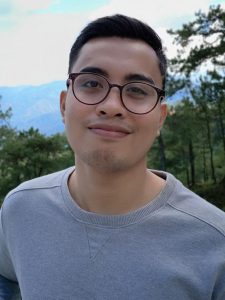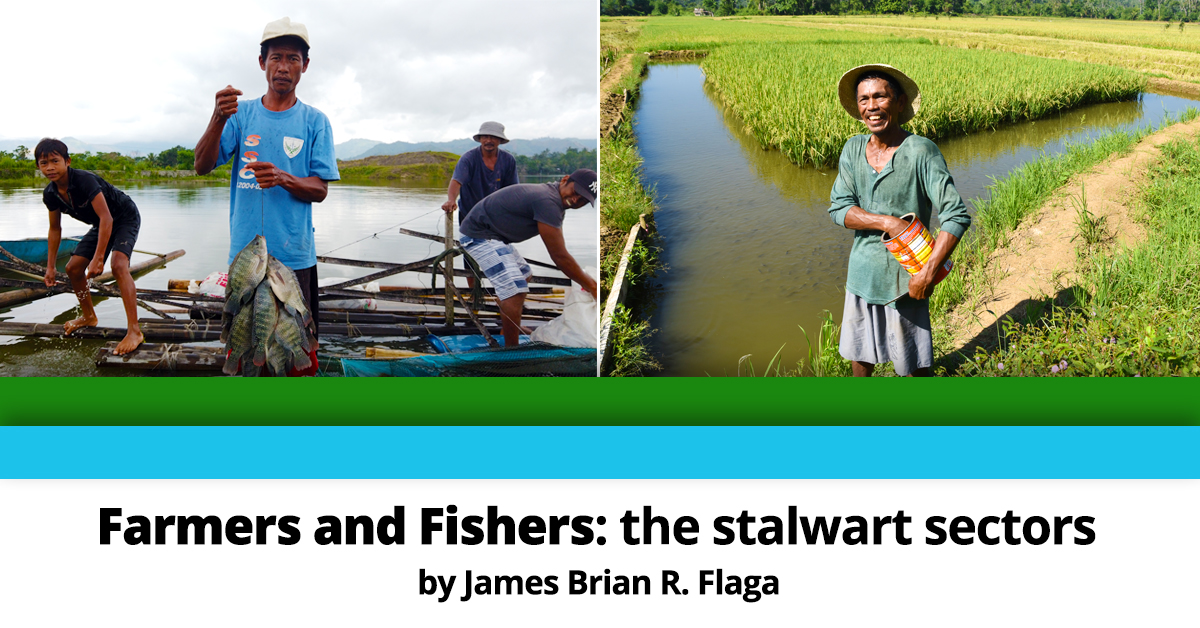Farmers and fishers, our country’s traditional backbone, should be given the most importance with or without this global pandemic.
Many have pointed out that these two sectors are overlooked, which is not really the case. In fact, the advances in agricultural science and technology have vastly improved our approaches and practices. These brought forward remarkable successes for the said two sectors, but among those inspirational stories, there are also of farmers and fishers on the trenches needing better systems, support, and training.
The fact of the matter is: A staggering majority of farmers and fishers remain impoverished. As per the Philippine Statistics Agency’s (PSA) report on Poverty Incidence Among Basic Sectors in 2018, the farmers (31.6%) and fishers (26.2%) are the top two poorest sectors which are especially prevalent in Geographically Isolated and Disadvantaged Area (GIDA) and End Local Communist Armed Conflict (ELCAC) areas.
Alner Sebio embodies the Filipino farmer ethics: hands and feet on the ground, eyes to the stars. A farmer in Kibaguio, Langtud, Laak, he tills close to a hectare of rolling land in the highlands, where he grows corn and bananas. Kibaguio is a GIDA in the province of Davao de Oro.
In December 2020, he sold 1,200 kilograms of white corn for a little more than Php 14,000. His produce formed part of the 69% production shared by Davao Region with two others (Northern Mindanao and BARMM) in the last quarter of 2020 based on the PSA.
In essence, Sebio produced a staple food for many Filipino families. He didn’t get to reap the maximum monetary compensation for it. As per the PSA, the average farmgate price for white corn in 2020 was at Php 13.75/kilo, down by 7% from the previous year’s prices at Php 16.20/kilo. Sebio sold his at Php 12/kilo.
It should be said: amid the CoViD-19 pandemic, while our healthcare workers are in the spotlight and given due credits for the service done, we as a nation are overlooking other sectors that are arguably the most important in making sure we thrive in these difficult times. They are the farmers and fishers – specifically, those who are in GIDA as well as ELCAC areas.
The CoViD-19 Pandemic
At the onset of the pandemic, the national government mandated the Department of Agriculture (DA) to ensure that every Filipino is food-secure while we wrestle with the health crisis.
One year into the pandemic and our farmers and fishers have not only sustained us but have done so outstandingly without fanfare.
In the second and third quarter of 2020, when intensive lockdowns paved the way for economic downturns, agricultural production punched in positive growth percentages at 0.5 and 0.7, respectively. The annual contribution of the sector to the 2020 gross domestic product contracted at 9.5% was deemed “negligible” by the Agriculture Secretary – which was an upright statement.
As restrictions ease and vaccines become available, there is no way for the agriculture sector not to increase production. Trust and believe. In our nation’s history, never has there been a major incident where our farmers and fishers have gravely failed us.
But the opposite is true. We have failed to reciprocate many times.
What is felt by our GIDA and ELCAC farmers during this pandemic is a microcosm of what is happening to agriculture in our country. While the CoViD-19 pandemic rages on, our farmers must be given the right prices for their produce.
In hinterland areas, the problem is always the right buyers. More often than not, our farmers will opt for the buyer who’s the most accessible, regardless of price. For some, the choice is inexistent.
I won’t go into a tangent of leading people to what they should be doing, but there’s a foolproof way of ensuring that you are doing your part of the solution. It’s been used by numerous communities worldwide since time immemorial: when you can, buy directly from farmers; when you can’t, insist on buying local.
SAAD – a hope for farmers and fishers
Several sectors, even the national government, have expressed their gratitude to our farmers and fishers amid this pandemic. The SAAD Program, which is intended to alleviate poverty at the household level, has changed its 2020 and 2021 plans from the ground up to answer to the President’s directive of ensuring there’s food for every Filipino.
Alner Sebio’s open-pollinated white corn variety was given by SAAD Region 11 in May 2020 through a masked up, socially distanced distribution. Though he opted not to replant, he used the money from his harvest to prepare his land for other crops. That’s the ingenuity of the Filipino farmer. He knows the land he is tilling, and he is decisive when and where it is needed.
Teodolo Bueno Jr., President of the Simbuco Aqua-Marine Multi-Purpose Cooperative (SAMMPC) attested that they started as a Bantay Dagat group, but because of SAAD, the cooperative was born. Through the program’s fish pen and seaweed projects, they made value-added products and achieved zero postharvest loss.
“Our cooperative is not affected by the pandemic because of the SAAD project. When CoViD-19 infiltrated the Philippines, this place was on lockdown but it seems like we are not because we got too busy with our SAAD project like installing our fish pens. We got a permit from the LGU and we even have our travel pass since we got our own truck. We travel to and from Cagayan De Oro to buy the materials for our fish pen,” Bueno shared.
On the other hand, Crispin Baldonaldo, president of Lala Fishermen’s Cooperative (LAFICO) shared that SAAD made it possible for them to acquire a beach resort and put up grocery stores.
“Because of SAAD, LAFICO really grows, we see how we transformed from being an OPAL association to a cooperative. Before, we will just wait for the right season to fish. But now, with the project provided to the cooperative, it is not just us members who benefit but almost all residents in the locality because our boneless bangus can be marketed in sidewalks,” Baldonaldo tearfully added.
More than implements and livelihood programs—and although it feels trite and reductive—SAAD as a whole delivers hope to our beneficiaries.
For SAAD Region 11, the budget allocation this year all poured into one province, which is the biggest yet, is reflective of what’s happening in other regions, with SAAD extending its areas of scope.
Of course, no program is perfect, because if there is, we would be living in a utopian society. But we don’t need to aspire to be living in one, as we all know, all kinds of societies have a little bit of both utopian and dystopian characteristics in them. To which, I digress: what SAAD has been doing at the grassroots level is only a part of the equation. We are not a banner program. We are a special one. There are limits and jurisdictions. At best, we’ll do what we are mandated to do. Possibly more. Hopefully more. And at worst, we’ve only done so little.
The African Swine Fever (ASF) that has threatened to wipe out a portion of our country’s livestock has affected our country’s production, caused pork prices to increase, and most especially, devastated the livelihood of our farmers. To a lot of backyard piggeries, those swine represented present plans, aspirations, even a glimpse of a better future. While repopulation is in the works, SAAD has done its due diligence by preparing relevant associations with social preparation activities and trainings through policies and guidelines.
On the similar side of the spectrum, fish fingerlings, chicken, goat, among others have been distributed all over the country amid the pandemic to increase production of other meat products. Simultaneously, harvests from projects distributed before the pandemic continue this year and the last, giving our beneficiaries reprieve in uncertain times.
Empowering ELCAC farmers is enabling the most vulnerable. Local communist rebellion targets these sectors to be part of their wider support network because they’re the ones with no better options. I’ve been lucky to be privy to a special presentation of a local military study done in a multi-year timeline that emphasizes the value of agriculture support in preventing ELCAC farmers from entering leftist indoctrination. In that roundtable, my biggest takeaway was support to GIDA and ELCAC farmers should be wider-spanning. If possible, permanent.
May pandemya man o wala, Magsasaka’t Mangingisda Maaasahan ng Bansa
Poverty is wearying to unpack akin to its cousins – war and crime. It is a multi-layered beast I fear I lack the sophistication to take on. There are people better suited to discuss those things. But this I know: in the short while that I’ve been an information officer for SAAD Region 11, the farmers I’ve talked to share a universal experience: the crushing dread of not being able to provide for their families on the next day.
Suffice it to say, most of us know and relate to this either partially or to its full extent. We have been in this situation before. We’ve lived it. We’ve seen it rear its ugly head. And while most of us have the convenience of brushing off these experiences with internet humor and other modern escapist methods, with these sectors, it’s a day-in-day-out lived experience.
It’s not so much to ask then, in celebration of Farmers and Fishers Month, that more than acknowledging the work these sectors have done, let’s give our farmers and fishers what they are due.
More, if we are able.
It is up to this generation to uplift our farmers and fishers. In a culture that asks people to be accountable, it’s not a stretch for us to ask how to change the way our farmers and fisherfolk live.
The systems are already in place. In some, we may need to topple and build from the ground up. In others, we may only need to tweak and adapt. ###
Reference:
Philippine Statistics Authority. January 2021. Palay and Corn Bulletin Quarterly Bulletin. p. 9 and 19 retrieved from https://psa.gov.ph/sites/default/files/Palay%20and%20 Corn%20Quarterly%20Bulletin%2C%20January%202021.pdf
About the Author:
James Brian R. Flaga is the Information Officer of SAAD Region XI and also an author of “The Girl He Knew and Other Short Stories”. A farmer’s son, he is working towards his masters in Literature.


Comments (0)